This is an encyclopaedia of armoured vehicles used by Wardie land during the war.
Armoured Cars
Imperial Automobiles RR (Rolls-Royce) Armoured car, entered service in 1916, can still be seen in the colonies as scouts and the imperial policing role

Imperial Automobiles LAC6 (Lanchester Armoured Car - 6 wheels), this 6-wheeled interwar armoured car is armed with a .50 Vickers and two .303 Vickers, LAC6 has a top speed of about 45 mph, a few LAC6s still serve in the colonies

Armoured Car Mk I (R), the BA-27 armoured car was a 1920s Soviet armoured car equipped with a 1.45 inch (37mm) tank gun, used by Snow Land, Wardie land captured some and used them in the Third Snow War 1939-1940 and in the Saqan Mercenary War of 1941
Armoured Car Mk I (R) in Western Colonies camo, ca. 1941
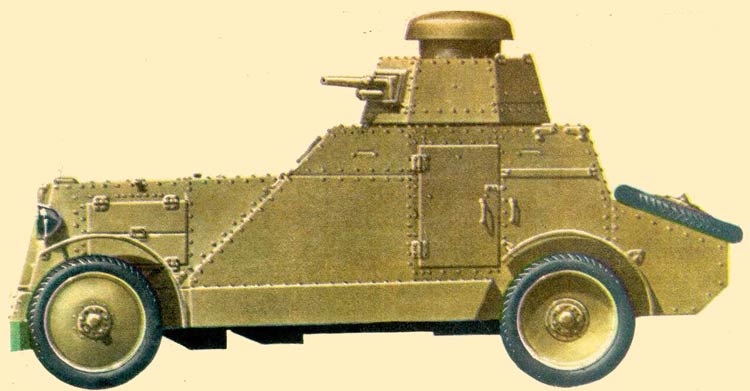
Armoured Car Mk II (R), the FAI-M was a Soviet armoured car of the early 1930s, Snow Land used a few, some were captured by Wardie land and used as the Armoured Car Mk II (R), the FAI-M used a 0.3 DT gun, though Wardie land also used 0.303 Vickers and .50 Vickers machine guns instead of the DT gun

Armoured Car Mk III (R), the BA-3 armoured car was a Soviet armoured car fitted with a T26 tank turret, and equipped with a 1.77 inch (45mm) 20K tank gun and 2 DT guns, Mk III* (R) was a model with a QF 2-pounder AT gun and 2 .303 Vickers guns

Tankettes
Carden Loyd tankette, this 1920s British tankette saw little service with the RIWTR in the war, since they had been mostly replaced by larger light tanks, however the Snow landian Pro-Empire Front used them more, Wardie land designation was "Tankette Mk I".

Tankette Mk I (R), the Tankette Mk I (R) was the designation for captured T-27 tankettes, thee T-27 was a 1930s Soviet tankette based on the Carden Loyd tankette, except the T-27's hull was larger and the running gear was improved, the T-27 was equipped with a single 0.3 inch (7.62mm) DT gun. Snow Land used the T-27 as a light scout, anti-infantry and artillery tractor tankette, Wardie land used them in the same role.
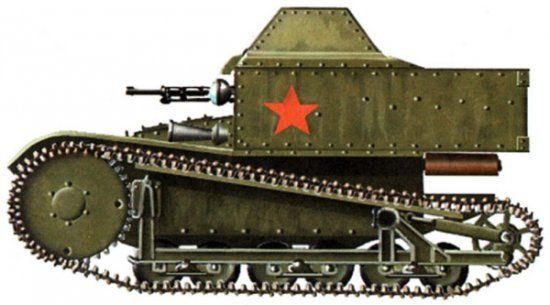
Type 94 tankette, an early 1930s Japanese tankette, saw some service with second-line armoured brigades, saw more service with the Pro-Empire Front, it was used in anti-infantry, infantry-support and recon roles, Wardie land designated was "Tankette Mk I (J)", "J" standing for "Japanese".

Type 97 Te-Ke, entered service in 1937, was primarily used as a scout, infantry support tank and against the T-26, outclassed by the BT tanks, Wardie land designation was "Tankette Mk II (J)"
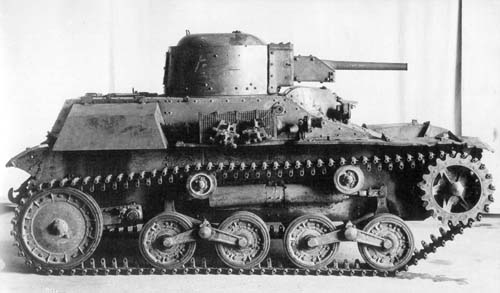
Light tanks
Renault FT, a WW1 light tank, saw service in rear-guard and training units, Wardie land designation was "Light Tank Mk I (F)", "F" standing for "French"
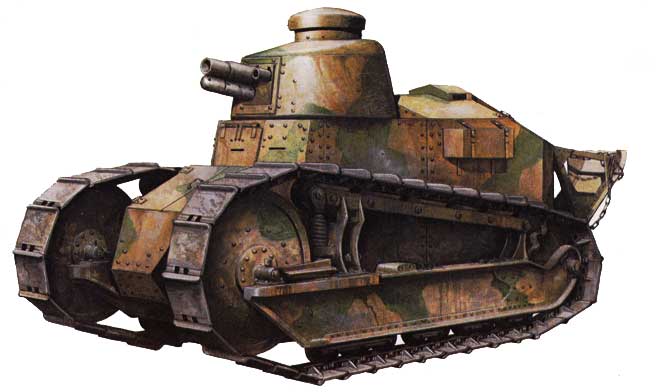
T1 Cunningham, a prototype US light tank of the 1920s, didn't see much service in the war due to be effectively obsolete, designated "Light Tank Mk I (A)" by Wardie land, "A" standing for "American".

Light Tank Mk I (G), based on the "Leichttraktor", an experimental German tank from 1930, they were intented to be used only by second-line tank squads during the war, however the Pro-Empire Front's front-line usage of them proved so successful against Snow land's T-26s they saw limited service with RIWTR front-line tank squads.

Light tank Mk VI, equipped with a Vickers .50 machine gun and a 0.303 Vickers co-axial machine gun, used primarily in the anti-infantry role, a favourite for imperial policing since entering service in 1936

Light tank Mk VII "Tetrarch", equipped with a QF 2 pounder gun, the Mk VII had several faults, a prime fault being the fact that the gunner or commander had to also act as a loader, in addition to his own duties, which caused delays in combat
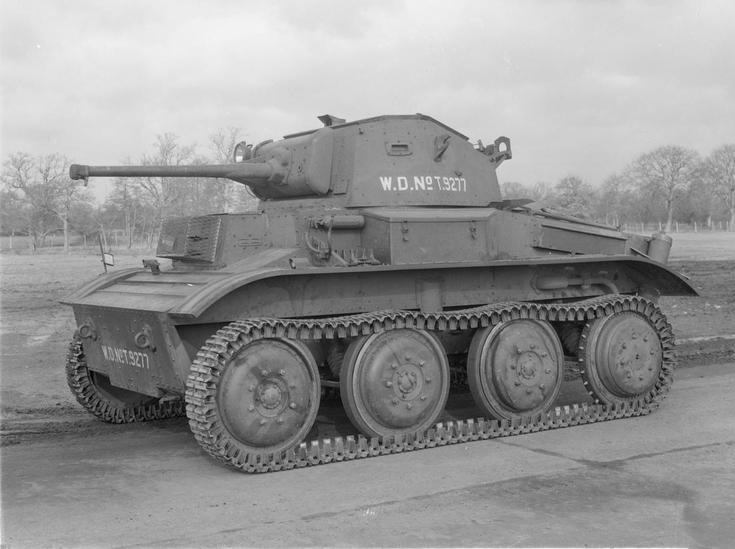
Vickers 6-ton, multiple variants were used
6-ton Mk I, anti-infantry tank
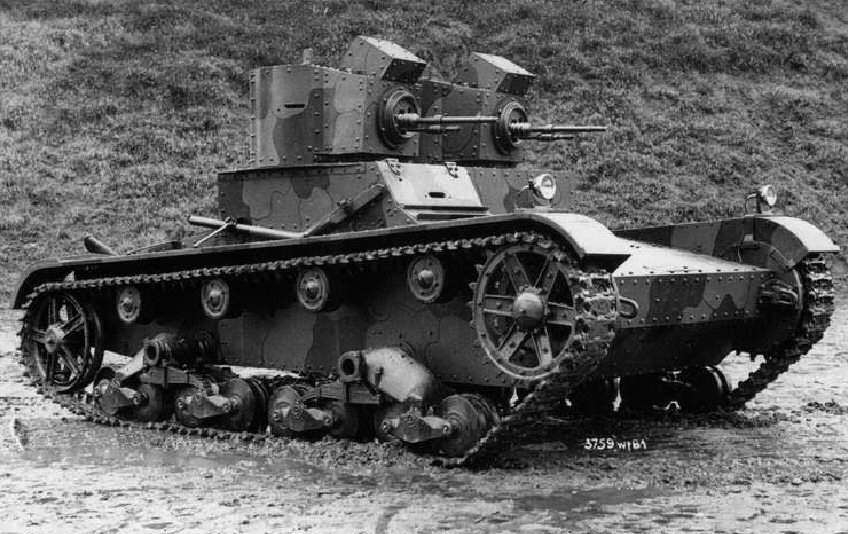
6-ton Mk II, equipped with a short-barrel 3-pounder gun, this was the most common type of 6-ton tank to see service

Type 95 Ha-Go, 1936 Japanese light tank, entered service in 1937, outclassed by the BT-5 and BT-7 in the war, but was more satisfactory against the T-26, primarily used for infantry support and scouting

T-26, some Snow landian tanks were captured during the war, most of them were T-26 tanks, the T-26 was used by Wardie land as a training and rear-guard tank, and by the Snow landian Pro-Empire Front on the frontlines, Wardie land/Snow landian T-26s were designated "Light Tank Mk I (R)", "R" standing for "Russian"

BT-series tanks, several variants of BT tank were supplied to Snow land by the USSR in the 1930s, these were the BT-2, BT-5 and BT-7. The BT tanks were superior to the T-26 and outclassed the Japanese tanks used by Wardie land and the SLPEF (though they struggled against Wardie land's British-designed medium tanks), however it was discovered they could be easily destroyed by anti-tank teams using petrol bombs. Examples of each of these variants were captured by Wardie land forces or Snow land Pro-Empire Front forces, the BT-2 was used only as a training tank (and as a second-line tank by the SLPEF), the BT-5 and BT-7 was used by both Wardie land and the SLPEF on the front lines.
BT-2 was designated "Light Tank Mk II (R)", BT-5 was designated "Light Tank Mk III (R)" and BT-7 was designated "Light Tank Mk IV (R)"
BT-2 tank

BT-5 tank

BT-7

LT Vz. 34, Czecoslovak light tank of 1934, saw only limited service in the war and had been largely supplanted by the Vz. 35 and Vz. 38 by Wardie land, designated "Light Tank Mk I (CZ)", "CZ" standing for "Czechoslovakian".
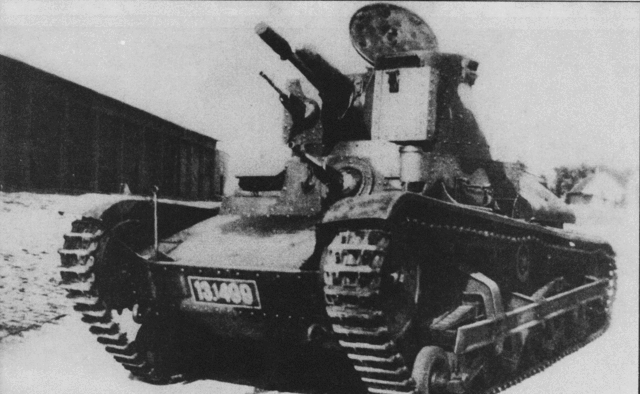
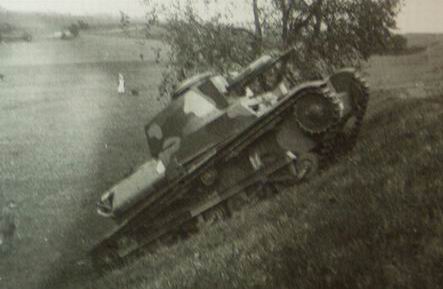
LT Vz. 35, a Czechoslovak light tank from 1935, entered service in 1935, armed with a Czeckoslovak PÚV vz. 34 anti-tank gun (the same type used on the Vz. 34) and 2 Vickers, Vickers K(T), Lewis and BESA machine guns (later also Browning and Bren guns), this tank was liked by crews. Wardie land designated was "Light Tank Mk II (CZ)".
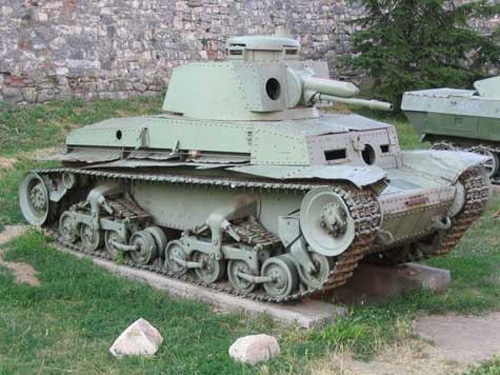
LT Vz. 35 in Home Islands/Jungle camo

LT Vz. 38, a Czechoslovak light tank from 1938, saw service with Wardie land and the SLPEF, was one of the heaviest tanks used by the SLPEF, who weren't allowed to use heavy tanks, and only used one type of medium tank, in case they decided to turn on the Wardie land allies, Wardie land designation was "Light Tank Mk III (CZ)".


Medium tanks (note the designation "Medium tank" was replaced by "Cruiser tank" and "Infantry tank" in late 1938)
Vickers Medium Mk I, this 1920s medium tank entered service with the RIWTR in 1926 and was used to great effect in the Saqan Rebellion of 1933, the Mk I was supplemented by the Mk II in 1929, the QF 3-pounder main gun proved to be good against the Snow landian T-26 tanks used in the Third Snow War

Medium Mk I in Home Islands/Jungle camo



Vickers Medium Mk IA*
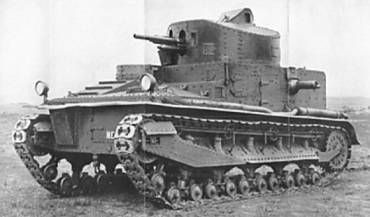
Vickers Medium Mk II, a slightly improved version of the Medium Mk I, entered service with the RIWTR in 1929 and served in the Saqan Rebellion of 1933 alongside the Mk I, during the Third Snow War the Quick-Firing 3-pounder main gun proved effective against the T-26s, captured Medium Mk Is and IIs used by Snow land were well-liked by the Snow landian tank crews who used them
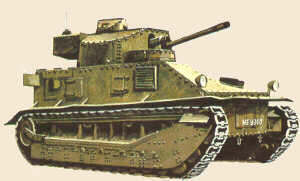
Vickers Medium Mk III (E3), the E3 was last of three Vickers Medium MK III tanks built, the E3 variant had improved suspension but didn't enter production due to its high price, in 1934 the Mk III E3s was licence-built by Wardie land Royal Imperial Armouries, 30 were built, they were deployed across the empire, 10 of them were sent to the northern colonies and took part in the Third Snow War, like the earlier Medium Mk I and Mk II tanks (which the Mk III wasn't based on, the Mk III was separate design) the Mk III had a 3-pounder gun, but also 3x 0.303 Vickers guns, the Mk III was one of the best tanks of the war, a combination of relatively heavy armour and power, the Mk III generally dominated the T-26, Snow land managed to capture one, but this was destroyed.

Type 89 I-Go, designed in 1928 and entered service with Japan in 1932, entered service with RIWTR in 1933, by 1939 was considered obsolete due to light armour because it was built to support infantry, rather than engage tanks, Wardie land used them as training or rear-guard tanks in the war, however they saw service on the frontlines with Snow landian Pro-Empire Front tank brigades, was satisfactory against the T-26 light tank, but was outclassed against the BT-5 and BT-7, designated "Medium Tank Mk I (J)" by Wardie land.

Type 97 Chi-Ha, Japanese medium tank of 1938-1943, entered Wardie land service in 1938 and used by second-line tank squads during the war, but on the front line by the Snow landian Pro-Empire Front, the main gun of the Type 89 I-Go, Type 95 Ha-Go, Type 97 Chi-Ha and Type 97 Chi-Ni was mediocre in performance, but was still effective against the T-26, however the BT-5 and BT-7 light tanks also used by Snow land outclassed all Japanese tanks in Wardie land service at the time, the BT's gun had longer range the Type 97, designated "Medium Mk II (J)" by Wardie land.

Type 97 Chi-Ni, intended as cheaper alternative to the Type 97 Chi-Ha, only one was produced in 1937 before the project was abandoned in favour of the technically superior but more expensive Type 97 Chi-Ha, the Chi-Ni was used in the war primarily as a scout and infantry support tank, the Chi-Ni's main gun, which was the same used on the Type 89 I-Go, Type 95 Ha-Go and Type Chi-Ha, was satisfactory against the T-26, but was outclassed by the 45mm gun of the BT-5 and BT-7, entered service in 1938 as the "Medium Tank Mk III (J)".
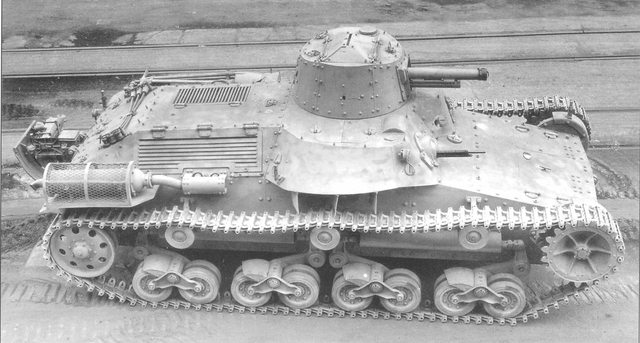
Medium Mk I (R), the Medium Mk I (R) was the Wardie land designated for captured Snow Landian T-28 multi-turret medium tanks in Wardie land service, Snow Land received 20 between 1934 and 1938, the main armament was a 3 inch (76.2mm) KT-28 tank gun, secondary armament was 4 or 5 0.3 inch (7.62mm) DT guns, Medium Mk I* (R) was a variant in which the KT-28 was replaced by a QF 2 pounder or QF 6 pounder, and the DT guns were replaced by 4 or 5 0.303 Vickers, .50 Vickers or 0.303 Bren guns



Cruiser tanks
Cruiser Mk I, entered service 1938, as a Cruiser tank the Cruiser Mk I was designed to use its fast speed to bypass main enemy lines (which would be left for the infantry and infantry tanks) and engage enemy communication lines and tanks in the rear, therefore they lacked the armour and firepower infantry tanks had, the Mk I served well hitting enemy supply lines and T-26 tanks, however was mechanically unreliable.

Cruiser Mk II, the Mk II had heavier armour than the Mk I and was designated a "heavy cruiser", the Mk II also served well behind enemy lines, disrupting supply convoys and destroy T-26 tanks, Cruiser Mk II only entered service in December 1939, so wasn't commonly seen during the war

Cruiser Mk III, Mk III used the Christie suspension, Mk III entered service in 1938, like the Cruiser Mk I it was under-armoured and mechanically unreliable, but still served well against enemy supply convoys, communications and light tanks like the T-26
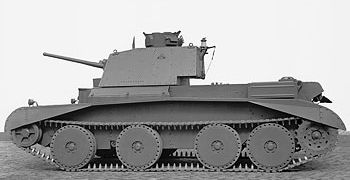
Société d'Outillage Mécanique et d'Usinage d'Artillerie (SOMUA) S35, French Cavalry tank (another name for a Cruiser tank) of 1936, 30 were bought in 1937, where they we're initially designated SOMUA Medium Mk I (S35) (the "(S35)" part of the designation being added to avoid confusion with the SOMUA S40, which was given the same designation) before the Medium class was split into Cruiser and Infantry tanks, in late 1938 they were re-designated SOMUA Cruiser Mk I (S35), several more S35s were delivered in 1943, the S35s delievered in 1943 were formerly captured and used by the Wehrmacht, before Germany passed some of their S35s on to their allies. In 1945 several S35s were refitted to take 17 pounder anti-tank guns.
As with many tanks Wardie land S35s went through several design changes, Mk I was the standard model equipped with the 1.9 inch (47 mm) SA 35 gun, Mk I* was equipped with a SOMUA S40 engine, which raised the top speed, Mk II used the more powerful 1.9 inch (47 mm) SA 37 gun, Mk III was refitted to take a QF 2 pounder gun, Mk III* was refitted to take a QF 3 pounder gun, Mk IV was equipped with a 3.7 inch field howitzer and Mk V was a tank destroyer refitted with a 17 pounder gun.

SOMUA Cruiser Mk I* in Home Islands/Jungle camo

SOMUA Cruiser Mk III in Home Islands/Jungle camo

Infantry tanks
Renault R35 light infantry tank, entered service in 1936 as Renault Medium Tank Mk I, in late 1938 was re-designated Renault Infantry Tank Mk I, was re-designated again in 1940 as the Renault Infantry Tank Mk I (R35) to avoid confusion with the related Renault R40 tank, which got the same designation.
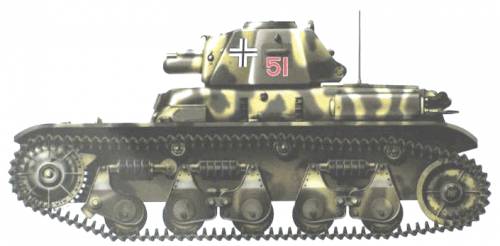
Renault R40 light infantry tank, the R40 was designed as an improvement over the R35, the R40 had a longer gun than R35 and modifications to the suspension system, some R40s entered service in 1940 and were designated Renault Infantry Tank Mk I (R40), to avoid confusion with the R35.
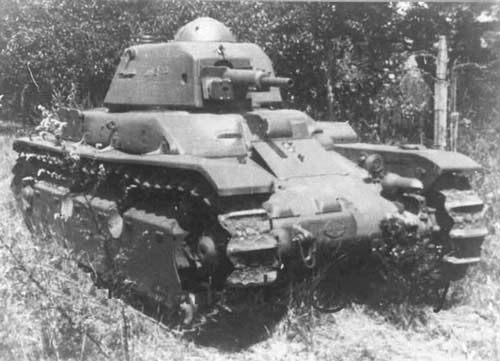
Matilda Mk I, the Matilda I entered service in 1938, Matilda I was equipped with a Vickers .303 machine gun or Vickers .50 machine gun, since Matilda I only used a machine gun it was not intended for attacking tanks, but for infantry support and attacking "soft" or lightly-armoured vehicles and buildings
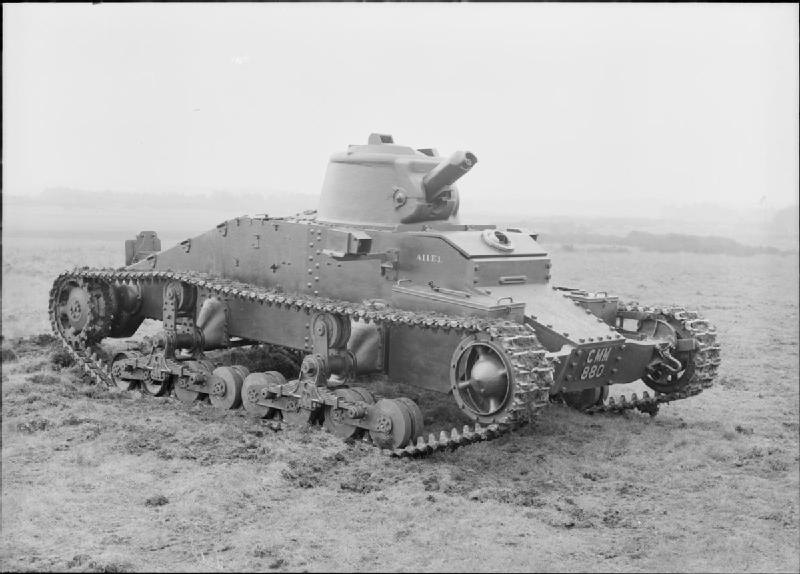
Matilda Mk I*, Matilda Mk I with Vickers machine gun replaced with a QF 2-pounder AT gun, meaning the Matilda Mk I packed more of a punch against enemy tanks.
Matilda Mk I* in a type of Home Islands/Jungle camo

Matilda Mk II entered service in November 1939, so they were rarely seen in the war, they had 2-pounder guns and heavy armour, and were among the best tanks to serve in the war, T-26 and BT tanks found it almost impossible to penetrate their armour, and the 2-pounder gun they used penetrated the thin armour of the T-26 and BT with ease, well-liked by crews their limited numbers meant the Snow landian Mechanised Army wasn't totally dominated by them
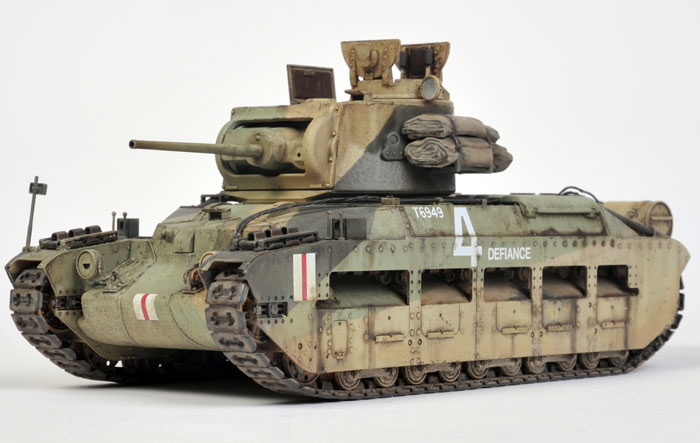
Matilda Mk II in Home Islands/Jungle camo

Heavy tanks
Vickers A1E1 Independent, a prototype heavy tank built in the 1920s, only one was built by Vickers before the project was abandoned due to lack of funds, Wardie land produced 15 in 1926-1929, 4 of them served in the Third Snow War, equipped with a QF 3-pounder main gun and 4x .303 Vickers machine-guns, the Independent tanks served well in the war

Heavy Tank Mk I (R), the Heavy Tank Mk I (R) was the Wardie land designation for captured Snow Landian T-35 heavy tanks, the T-35 was a Soviet 1930s multi-turret heavy tank, of which 10 were delivered to Snow Land in 1937, the T-35 was equipped with a 3 inch (76.2mm) gun, 2x 1.77 inch (45mm) 20K guns and 5 or 6 0.3 (7.62mm) DT guns. 4 were captured by Wardie land, and the other 6 destroyed, Snow Land attempted to receive more after war broke out, but the Wardie land Imperial Navy and Snow Landian Pro-Empire Front Fleet sank the cargo transports carrying them. In 1945 two of the Heavy Tank Mk I (R)'s were re-equipped with a 17 pounder AT gun, 2x QF 2 pounder tank guns and 5 or 6 0.303 Vickers, .50 Vickers or 0.303 Bren guns, these were designated Heavy Tank Mk I* (R).



